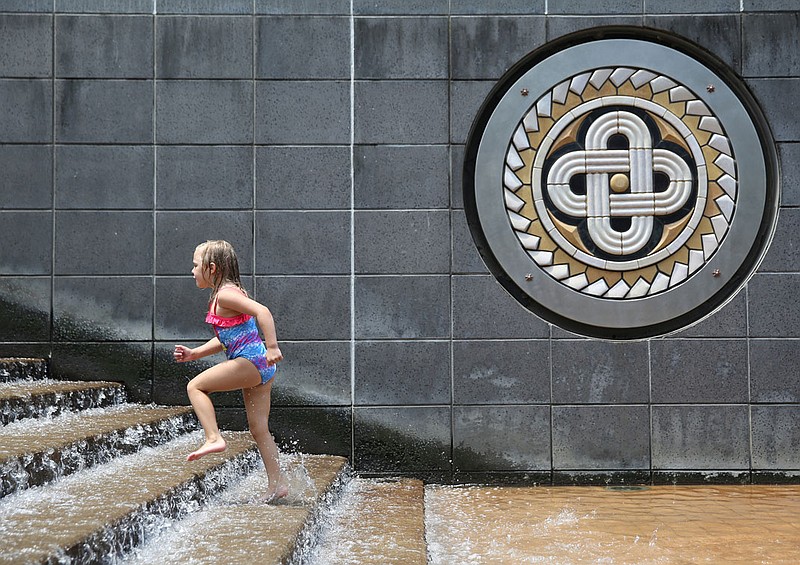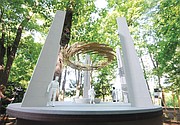The opportunities cities promise have almost always drawn very different people together. These tensions have no doubt birthed tragic histories. But they have also served to illuminate the unique beauty found in a diversity of cultures and identities.
All of this has been enormous fodder for artists, who are more and more being looked to by cities like Chattanooga to help create a shared sense of place, despite the cacophony of lived experiences.
More Info
» The vibrant arts scene also encompasses a number of community theaters, galleries, events and classes. To keep up to date, visit timesfreepress.com/mychatt.
The city of Chattanooga, which adopted a bold, 10-year vision for public art in February, began to invest in public art and placemaking in the mid-1980s. Post-industrial cities were hemorrhaging residents and jobs. Yet, some cities were spreading the idea that public art and placemaking could make city grit more palatable and even lead to revival and reinvestment. In many cases, they were right.
Beyond the aesthetic, however, public art was also beginning to be seen as a locus of education and reconciliation.
When the Tennessee Aquarium - one of the physical byproducts of the city's renowned citizen-led visioning process - and the public park surrounding it was expanded, planners intentionally incorporated public art that honored the Cherokee people, who were forcibly removed from Chattanooga, causing thousands to die along the mandated trek to Oklahoma. The opening of "The Passage at Ross's Landing" in 2005, on the site where the Cherokee's Trail of Tears began, was one of the few times that all three Cherokee chiefs had come together, post-removal.
"Many years ago, this passage divided us," said Eastern Band Chief Michell Hicks, who spoke during one of the events organized to celebrate the opening of the artist-envisioned water feature. "This place remembers before we were divided. The water holds our tears of joy and sorrow, the rocks hold the sounds of our great Cherokee language, the soil has absorbed our blood and continues to clutch at our footsteps. How great for a passage that once tore us apart to finally bring us together."
California author Courtney Elizabeth Knapp, whose book about race and urban planning in Chattanooga, "Constructing the Dynamo of Dixie," which was published last year, says Chattanooga stood out to her because of its approach to "The Passage."
"A lot of the conversations cropping up now around racism and memorials and peacemaking, it wasn't a major conversation like it is today," says Knapp, now an associate professor of city and regional planning at the Pratt Institute in New York. "They (leaders) apologized for the history that had taken place in the city. I hadn't seen other cities do it in an intentional way."
Current projects
Public Art Chattanooga manages over 100 permanent works around the city in addition to temporary exhibitions — murals, sculptures and rotating exhibits. One of the most recent is a contemporary addition to the alleyway between Chattanooga Billiard Club and Market City Center downtown.PAC has two new projects in the works:› The Fallen Five Memorial, honoring the five servicemen who lost their lives in an attack on the local Armed Services Recruiting Center in July 2015, is due to open at the Tennessee Riverpark this July.› The organization is also working to install a sculpture at Tacoa Park in Brainerd. The piece, by artist who, is meant to represent what, and is the latest in a line of similar installations at municipal parks that extend PAC’s presence beyond the downtown core.
Though not related to the ongoing efforts of the city itself, the forthcoming Ed Johnson Memorial should add fodder for such conversations. Earlier this spring, Hamilton County commissioners approved $100,000 toward the independent citizen-led movement to honor Johnson, whose pre-trial lynching at the hands of an angry mob in 1906 led to a federal overhaul of the justice system's due process.
"The blood of Ed Johnson is on the hands of Hamilton County, and we should do what's right," Commissioner David Sharpe said when the funds were approved in late March.
The city's new 10-year public art plan, which involved consultants Gail Goldman and Barbara Goldstein and nearly a year full of focus groups and input sessions, was a large effort toward codifying that kind of intentionality, says Katelyn Kirnie, director of Public Art Chattanooga.
The plan was undertaken for two reasons. Some felt minority communities and minority artists were not being given equitable access to public art opportunities and resources, and they wanted the city to address the concern. Others wanted a plan to assist with economic development. Chattanooga's placemaking efforts have garnered the city a lot of press in recent years, so many felt it was time to think about the future. Since the renaissance, public art has been bolstered by public funds, as well as by significant private financial support from foundations and individuals. Consultants for the new plan recommended that 2 percent of the city's capital budget, which will fluctuate each year, should be designated for public art investment.
The final report was the culmination of 32 interviews, six focus groups, one roundtable discussion, two community input sessions with Chattanooga Mayor Andy Berke, two advisory committee meetings, six community presentations, three awareness building events and 222 surveys collected, according to Public Art Chattanooga's website.
Rondell Crier, a community artist who serves on the city's Public Art Commission, says he and other community members voiced concerns at the beginning of the planning process about what they saw as a lack of real effort to gather community input on public art and related spending. Midway through, more effort was put toward gathering community voices.
"The leadership did, at some point, realize that there was a shortcoming to making sure the community was involved in the process, and implemented just enough measures to, sort of, roughly satisfy what community engagement looks like," says Crier.
Funded by the city and local nonprofits the Lyndhurst Foundation and the Footprint Foundation, the process taught a lot about how the city can increase diversity in public art, Kirnie says.
"The public art field is a specialized field; a painter may not have the studio set up or equipment to produce at a large scale," she explains. "When we talk about making it more accessible, we need to build capacity in our minority artists. Action steps are programs that would expand and cultivate local artists, providing mentorships for artists to learn from more established public artists, testing new art forms."
The plan suggests many action steps toward the goals of placemaking, community empowerment, economic development and operational objectives, but the most significant action item is a new effort to integrate public art, especially homegrown public art that is neighborhood specific, into capital building and infrastructure projects, says Kirnie.
"The major capital projects the city is taking on, public art is tied into that," she says. "For example, the youth and family development center being built [in Avondale] - artwork can be integrated into how it is built."
The city is spending $6 million to build the new Youth & Family Development Center, which will more than double the square footage of the current Avondale center and is expected to be completed this spring, though plans to integrate art have not been finalized.
The plan's recommendations also include creating an artist-in-residency program "with a goal of creating deep engagement within communities to identify locations and goals for public art projects in their neighborhoods," Kirnie says, and stabilizing public art funding for more equitable distribution of public art across the city.
Isaac Duncan III, a local artist, says he is fully behind the plan and hopes the city actually backs it financially.
"People can talk about having all these different opportunities or targeted diverse opportunities, but if the city doesn't support it, the council members, then it isn't doing anything," Duncan says. "We have ridden the way of foundations supporting things for so long."
Matthew Dutton, a surrealist sculptor who works in Chattanooga and participated in the planning process, says he really thinks the plan will generate opportunities for those who have felt left out.
"Public art will strive to push beyond its current footprint to reach underserved neighborhoods, which in turn could result in a stronger sense of community ownership and empowerment," he says.
The plan will certainly ensure that art - hopefully community-envisioned and community-reflecting art - will remain a part of Chattanooga's sense of place, he adds.
"This plan hopefully helps ensure that all community members have access and opportunities to contribute to what our city looks and feels like," says Dutton. "Future art-makers and deciders will greatly benefit from the strong groundwork that is being laid before them."
ACTION PLAN HIGHLIGHTS
PLACEMAKINGEarly artist engagement for site-integrated artworks in city infrastructure projects.Identify locations where community-based public art can be integrated into ongoing citywide urban design efforts.Recruit local artists to collaborate with residents and businesses to enhance neighborhood character in underserved communities.Budget Policy and Capital Improvement Project (CIP) guidelines that allocate a percentage of the city’s overall above-ground CIP budget for integrated public art.COMMUNITY EMPOWERMENTOpportunities for local and regional artists (creative engagement, residencies, training and mentorships).Prioritize projects in neighborhoods that lack public art and in low-income neighborhoods identified for streetscape improvements.Roster of local and regional artists who have an interest in and track record of working with community groups.Artist-in-residencies with a goal of creating deep engagement within communities to identify locations and goals for public art projects in their neighborhoods.ECONOMIC DEVELOPMENTTraining tools and streamlined review procedures for private and nonprofit organizations that initiate and manage art on both private and public property.Toolkit of resources for interested partners and developers reflecting best practices and industry standards on public art project implementation.Roster of local artists who can participate in Neighborhood Reinvestment Fund projects for façade improvements, street furniture and other placemaking amenities.OPERATIONAL OBJECTIVESEquitable geographic distribution of artwork, increasing access to public art citywide.Stable source of funding to staff Public Art Chattanooga, maintain the public art collection and commission new works.Continue strong partnerships between the local government, businesses, private developers, and foundations.Policies that adequately address the growth of the public art collection and its ongoing maintenance.

